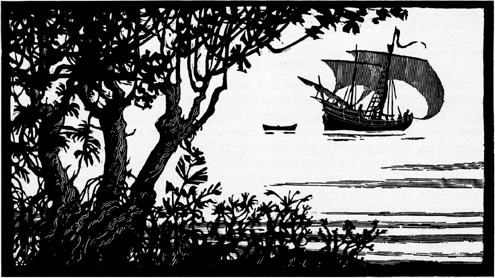
As many of us are celebrating Easter with our families this weekend, I thought it would be appropriate to recall one of the great maritime discoveries made during the Easter holiday, the official discovery and naming of Florida back in 1513. Ponce de Leon made first landfall on Florida sands somewhere in the vicinity of Ponte Vedra right here on our First Coast. Florida got its name because the discovery was made during Eastertide or the Easter Season, exemplified by the Spanish Catholic Pascua Florida (“flowery festival” or “feast of flowers”).
Our friend Davis Walker of Florida Living History, Inc., sends out fantastic Florida history posts on a regular basis. I thought I’d share his most recent, a brief overview of the expedition that formally discovered Florida. He writes:
April 3, 1513: Don Juan Ponce de León (1474-July 1521), the “First Conquistador,” veteran of the Reconquista, companion of Christopher Columbus, conqueror and governor of Borinquén (now Puerto Rico), knight of the Order of Calatrava, is commissioned by his King, Ferdinand of Spain, to discover and explore “Terra Bimini,” unknown land to the northwest of Borinquén. His small squadron of three ships – the Santiago (caravel), the Santa María de la Consolación (nao), and the San Cristóbal (bergantín) – sails from Aguada, Puerto Rico on March 3rd. The “First Fleet” is piloted by Anton de Alaminos, perhaps the greatest Caribbean navigator of his day. On board are about 65 companions – white mariners and soldiers (including one white slave, Juan de León), two Native American slaves (Perico and Fernando), two free black Africans (both named Jorge), and one woman (Juana Jiménez). These last will become the first blacks and the first European woman known to set foot in the continental U.S.
It is believed that Ponce may have brought with him a few cattle and his chestnut-colored mare, the first of their kind to come to the North American continent. On April 2nd, the “First Fleet” sights what they believe to be a large island (in fact, continental North America). Ponce names this land “La Florida” (i.e., “the Flowery One;” the oldest European place name still in use on the North American continent) because of the beauty of its vegetation and because it was Eastertide, the Pascua Florida of the religious calendar. On April 3rd, he lands “to gather information and take possession.” Continuing to sail down the eastern coast of La Florida, Ponce is the first known European to encounter the Gulf Stream, off present-day West Palm Beach. This discovery provides the basis for the historic sailing route for exiting the Gulf of Mexico and the western Caribbean Sea – as his comrade, Columbus, had discovered the route to the New World, so Ponce discovers the return route to Europe.
Devereux, Anthony Q.; Juan Ponce de León, King Ferdinand and the Fountain of Youth; The Reprint Company, Spartanburg, SC; ISBN: 0871524643; 1993.
Fernández de Oviedo y Valdés, Gonzalo; Historia General y Natural de las Indias; Ediciones Atlas, Madrid; 1851; repr. 1944, 1959.
Fuson, Robert Henderson; Juan Ponce de León and the Spanish Discovery of Puerto Rico and Florida; McDonald & Woodward Pub. Co., Blacksburg, VA; ISBN: 093992384X; 2000.
Herrera y Tordesillas, Antonio; Historia general de los hechos de los Castellanos en las Islas y Tierrafirme del mar oceano; 1601.
Hoffman, Paul E.; “Ponce de León, Juan”; American National Biography Online, Feb. 2000, American Council of Learned Societies. Published by Oxford University Press
Morison, Samuel E.; The European Discovery of America: The Southern Voyages, vol. 2; Oxford University Press, Oxford; ISBN: 0195018486; 1974.
Quinn, David B., ed.; New American World: A Documentary History of North America to 1612, vol. 1; Arno Press, New York; ISBN: 0405107595; 1979.
Tío, Aurelio, ed.; “Historia del descubrimiento de la Florida y Beimeni o Yucatan,” Academia Puertorriqueña de la historia, Boletín 2, no. 8 (1972)
Nuevas Fuentes para la Historia de Puerto Rico: documentos inéditos o poco conocidos cuyos originales se encuentran en el Archivo General de Indias en la ciudad de Seville, España; Ediciones de la Universidad Interamericana de Puerto Rico, San Germán, PR; 1961.
Weddle, Robert S.; Spanish Sea: The Gulf of Mexico in North American Discovery, 1500-1685; Texas A&M University Press, College Station, TX; ISBN: 0890962111; 1985.
To commemorate this historical event, the first annual Ponce de León historical muster will be held on April 10, 2010, in St. Augustine, Florida, at the Fountain of Youth Archaeological Park. Hosted by the living history group, La Compañía de Juan Ponce de León / The Company of Juan Ponce de León (c. 1513-21), this heritage event will feature interpretations, lectures, and demonstrations on the life of Don Juan, his companions, the early Spanish explorers and settlers of Florida and the Caribbean, and the Native Americans they encountered. The event will include a lecture by LAMP Director of Archaeology Dr. Sam Turner, who is an expert on 16th century Spanish maritime history and on Ponce de Leon in particular.
For more information on this event, including the scheduled programming, click here.
Thanks to Davis for reminding us of this pivotal moment in history, and for the upcoming heritage event. I hope you all enjoy this holiday weekend with your families!

